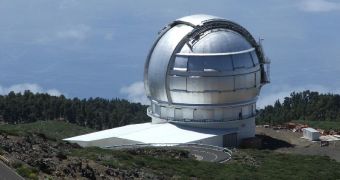The world's largest telescope will make its first observations this week, in a "first light" ceremony, after 17 years of construction. Although not fully completed, it will be able to take its first look at the sky on July 13, so its makers are not at all superstitious.
Gran Telescopio Canarias, or GTC, sometimes called GranTeCan, has the largest mirror of any reflecting telescope, 10.4 meters (34.1), that has already been installed in time for the ceremony. So far, only 12 of the 36 mirrors are in place, the rest being expected to be mounted this year, with the telescope's grand opening - to be presided over by King Juan Carlos I of Spain - set for next summer.
After that date, quality scientific observations will begin, although for now it is able to perform initial test runs. At 10 p.m. GMT this Friday, Prince Felipe, heir to the Spanish throne, will train the telescope on Polaris, the North Star, for a ceremonial observation to be attended by about 300 people, at the Observatorio del Roque de los Muchachos on the island of La Palma, Spain.
The GTC Project is a partnership formed by several institutions from Spain (90%), Mexico (5%) and the University of Florida (USA) (5%) and an initiative from the Instituto de Astrof?sica de Canarias (IAC).
One of the first instruments already installed is an infrared imager and spectrometer, built by the University of Florida, the American $5 million contribution to the project, that will allow US scientists 20 nights of telescope time annually for observations.
"We are not just passive partners in this project," said Stan Dermott, astronomy department chairman at the UF. "We are the world's leader in developing astronomical instruments, and our instrument, CanariCam, will be one of the first instruments used on the GTC."
"Already we are forming scientific teams that will involve other telescopes to take part in surveys of the distant universe," he said. "For example, Rafael Guzman is leading a team that will investigate the origin of galaxies. In a sense, we have joined the club of big observers now," concluded Dermott.

 14 DAY TRIAL //
14 DAY TRIAL //